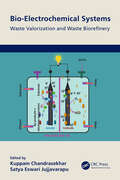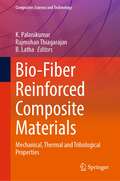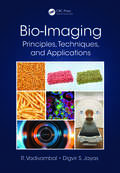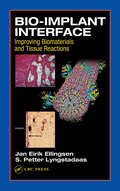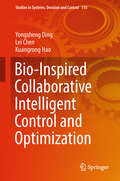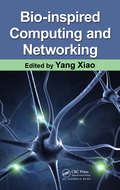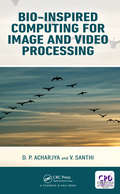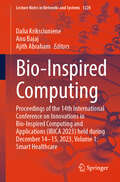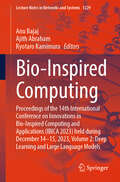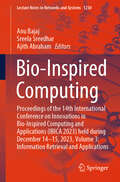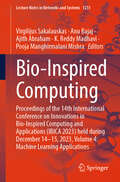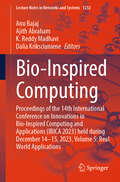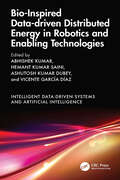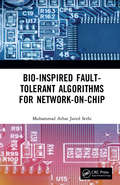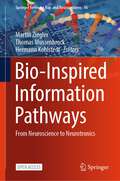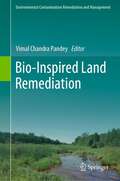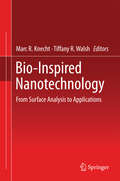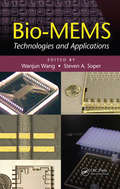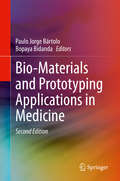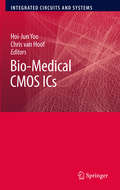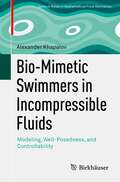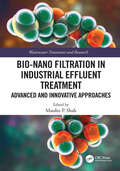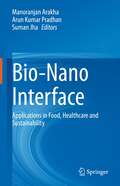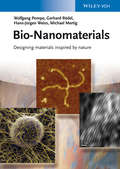- Table View
- List View
Bio-Electrochemical Systems: Waste Valorization and Waste Biorefinery
by Kuppam ChandrasekharThis book addresses electro-fermentation for biofuel production and generation of high-value chemicals and biofuels using organic wastes. It covers the use of microbial biofilm and algae-based bioelectrochemical systems (BESs) for bioremediation and co-generation of valuable chemicals, including their practical applications. It explains BES design, integrated approaches to enhance process efficiency, and scaling-up technology for waste remediation, bio-electrogenesis, and resource recovery from wastewater. Features: Provides information regarding bioelectrochemical systems, mediated value-added chemical synthesis, and waste remediation and resource recovery approaches. Covers the use of microbial biofilm and algae-based bioelectrochemical systems for bioremediation and co-generation of valuable chemicals. Explains waste-to-energy related concepts to treat industrial effluents along with bioenergy generation. Deals with various engineering approaches for chemicals production in eco-friendly manner. Discusses emerging electro-fermentation technology. This book is aimed at senior undergraduates and researchers in industrial biotechnology, environmental science, civil engineering, chemical engineering, bioenergy and biofuels, and wastewater treatment.
Bio-Fiber Reinforced Composite Materials: Mechanical, Thermal and Tribological Properties (Composites Science and Technology)
by K. Palanikumar Rajmohan Thiagarajan B. LathaThis book provides an overview on the latest technology and applications of bio-based fiber composite materials. It covers the mechanical and thermal properties of bio-fibers for polymeric resins and explains the different pre-treatment methods used by the researchers for the enhancement. In addition, this book also presents a complete analysis on the tribological behavior of bio-fiber reinforced polymer composites to appreciate the friction and wear behavior. This book would be a handy to the industrial practitioners and researchers in the direction of achieving optimum design for the components made of natural fiber based polymer matrix composites.
Bio-Imaging: Principles, Techniques, and Applications
by Rajagopal Vadivambal Digvir S. JayasHighlights the Emergence of Image Processing in Food and AgricultureIn addition to uses specifically related to health and other industries, biological imaging is now being used for a variety of applications in food and agriculture. Bio-Imaging: Principles, Techniques, and Applications fully details and outlines the processes of bio-imaging applica
Bio-Implant Interface: Improving Biomaterials and Tissue Reactions
by J.E. Ellingsen S.P. LyngstadaasAchieving good clinical outcomes with implanted biomaterials depends upon achieving optimal function, both mechanical and biological, which in turn depends upon integrating advances realized in biological science, material science, and tissue engineering. As these advances push back the frontiers of biomaterial medicine , the control and patterning
Bio-Inspired Algorithms in PID Controller Optimization (Intelligent Signal Processing and Data Analysis)
by Nilanjan Dey Jagatheesan Kallannan Anand Baskaran Amira AshourThis book discusses in-depth role of optimization to optimize the controller parameters with reference to bio-inspired algorithms. Comparative studies to evaluate the performance of different optimization techniques in terms of the settling time, overshoot and undershoot responses of the frequency deviations, tie-line power flow deviations, and the area control error are included, supported by examples. The book also includes different scenarios of the load frequency controller for single area as well as multi-area thermal power generating unit considering different algorithms. Key Features: Highlights the importance of tuning the power system controller parameters with emphasis on bio-inspiration algorithms Provides some applied applications/examples of the thermal power system Focusses on power system applications based on the optimization algorithms with different single area and multi-area thermal power systems Reports different cases on the interconnected power systems with providing optimal performance by optimizing the controller’s parameters
Bio-Inspired Collaborative Intelligent Control and Optimization (Studies in Systems, Decision and Control #118)
by Lei Chen Yongsheng Ding Kuangrong HaoThis book presents state-of-the-art research advances in the field of biologically inspired cooperative control theories and their applications. It describes various biologically inspired cooperative control and optimization approaches and highlights real-world examples in complex industrial processes. Multidisciplinary in nature and closely integrating theory and practice, the book will be of interest to all university researchers, control engineers and graduate students in intelligent systems and control who wish to learn the core principles, methods, algorithms, and applications.
Bio-Inspired Computing and Networking
by Yang XiaoSeeking new methods to satisfy increasing communication demands, researchers continue to find inspiration from the complex systems found in nature. From ant-inspired allocation to a swarm algorithm derived from honeybees, Bio-Inspired Computing and Networking explains how the study of biological systems can significantly improve computing, networki
Bio-Inspired Computing for Image and Video Processing
by V. Santhi D. P. AcharjyaIn recent years bio-inspired computational theories and tools have developed to assist people in extracting knowledge from high dimensional data. These differ in how they take a more evolutionary approach to learning, as opposed to traditional artificial intelligence (AI) and what could be described as 'creationist' methods. Instead bio-inspired computing takes a bottom-up, de-centralized approach that often involves the method of specifying a set of simple rules, a set of simple organisms which adhere to those rules, and of iteratively applying those rules. Bio-Inspired Computing for Image and Video Processing covers interesting and challenging new theories in image and video processing. It addresses the growing demand for image and video processing in diverse application areas, such as secured biomedical imaging, biometrics, remote sensing, texture understanding, pattern recognition, content-based image retrieval, and more. This book is perfect for students following this topic at both undergraduate and postgraduate level. It will also prove indispensable to researchers who have an interest in image processing using bio-inspired computing.
Bio-Inspired Computing: Proceedings of the 14th International Conference on Innovations in Bio-Inspired Computing and Applications (IBICA 2023) held during December 14-15, 2023, Volume 1: Smart Healthcare (Lecture Notes in Networks and Systems #1228)
by Ajith Abraham Dalia Kriksciuniene Anu BajajThis book presents 53 selected papers focused on Smart Health Care from the 14th International Conference on Innovations in Bio-Inspired Computing and Applications (IBICA 2023) and 13th World Congress on Information and Communication Technologies (WICT 2023), which was held in five different cities namely Olten, Switzerland; Porto, Portugal; Kaunas, Lithuania; Greater Noida, India; Kochi, India and in online mode. The 23rd International Conference on Hybrid Intelligent Systems (IBICA-WICT 2023) was focusing on synergistic combinations of multiple approaches to develop the next generation of bio-inspired computing and ICT systems. IBICA-WICT 2023 had contributions by authors from 36 countries. This book offers a valuable reference guide for all medical doctors, scientists, academicians, researchers, students, and practitioners in the field of artificial intelligence and smart health care.
Bio-Inspired Computing: Proceedings of the 14th International Conference on Innovations in Bio-Inspired Computing and Applications (IBICA 2023) held during December 14-15, 2023, Volume 2: Deep Learning and Large Language Models (Lecture Notes in Networks and Systems #1229)
by Ajith Abraham Anu Bajaj Ryotaro KamimuraThis book presents 53 selected papers focused on Deep Learning and Large Language Models from the 14th International Conference on Innovations in Bio-Inspired Computing and Applications (IBICA 2023) and 13th World Congress on Information and Communication Technologies (WICT 2023), which was held in five different cities namely Olten, Switzerland; Porto, Portugal; Kaunas, Lithuania; Greater Noida, India; Kochi, India and in online mode. The 23rd International Conference on Hybrid Intelligent Systems (IBICA-WICT 2023) was focusing on synergistic combinations of multiple approaches to develop the next generation of bio-inspired computing and ICT systems. IBICA-WICT 2023 had contributions by authors from 36 countries. This book offers a valuable reference guide for all scientists, academicians, researchers, students, and practitioners focused on advanced machine learning including deep learning methods, large language models, and its real-world applications.
Bio-Inspired Computing: Proceedings of the 14th International Conference on Innovations in Bio-Inspired Computing and Applications (IBICA 2023) held during December 14-15, 2023, Volume 3: Information Retrieval and Applications (Lecture Notes in Networks and Systems #1230)
by Ajith Abraham Anu Bajaj Sreela SreedharThis book presents 51 selected papers focused on Information Retrieval and Applications from the 14th International Conference on Innovations in Bio-Inspired Computing and Applications (IBICA 2023) and 13th World Congress on Information and Communication Technologies (WICT 2023), which was held in five different cities namely Olten, Switzerland; Porto, Portugal; Kaunas, Lithuania; Greater Noida, India; Kochi, India and in online mode. IBICA-WICT 2023 had contributions by authors from 36 countries. This book offers a valuable reference guide for all scientists, academicians, researchers, students, and practitioners focused on Information Retrieval and Applications.
Bio-Inspired Computing: Proceedings of the 14th International Conference on Innovations in Bio-Inspired Computing and Applications (IBICA 2023) held during December 14-15, 2023, Volume 4: Machine Learning Applications (Lecture Notes in Networks and Systems #1231)
by Ajith Abraham Virgilijus Sakalauskas Pooja Manghirmalani Mishra Anu Bajaj K. Reddy MadhaviThis book presents 53 selected papers focused on Machine Learning and Applications from the 14th International Conference on Innovations in Bio-Inspired Computing and Applications (IBICA 2023) and 13th World Congress on Information and Communication Technologies (WICT 2023), which was held in five different cities namely Olten, Switzerland; Porto, Portugal; Kaunas, Lithuania; Greater Noida, India; Kochi, India and in online mode. IBICA-WICT 2023 had contributions by authors from 36 countries. This book offers a valuable reference guide for all scientists, academicians, researchers, students, and practitioners focused on Machine Learning and Applications.
Bio-Inspired Computing: Proceedings of the 14th International Conference on Innovations in Bio-Inspired Computing and Applications (IBICA 2023) held during December 14-15, 2023, Volume 5: Real World Applications (Lecture Notes in Networks and Systems #1232)
by Ajith Abraham Dalia Kriksciuniene Anu Bajaj K. Reddy MadhaviThis book presents 53 selected papers focused on Machine Learning and Applications from the 14th International Conference on Innovations in Bio-Inspired Computing and Applications (IBICA 2023) and 13th World Congress on Information and Communication Technologies (WICT 2023), which was held in five different cities namely Olten, Switzerland; Porto, Portugal; Kaunas, Lithuania; Greater Noida, India; Kochi, India and in online mode. IBICA-WICT 2023 had contributions by authors from 36 countries. This book offers a valuable reference guide for all scientists, academicians, researchers, students, and practitioners focused on real-world applications of modern ICT and bio-inspired computing.
Bio-Inspired Data-driven Distributed Energy in Robotics and Enabling Technologies (Intelligent Data-Driven Systems and Artificial Intelligence)
by Abhishek Kumar Ashutosh Kumar Dubey Hemant Kumar Saini Vicente García-DíazThis book begins by introducing bio-inspired data-driven computation techniques, discussing bio-inspired swarm models, and highlighting the development of interactive bio-inspired energy harvesting systems to drive transportation infrastructure. It further covers important topics such as efficient control systems for distributed and hybrid renewable energy sources, and smart energy management systems for developing intelligent systems. This book: Presents data-driven intelligent heuristics for improving and advancing environmental sustainability in both eco-cities and smart cities. Discusses various efficient control systems for distributed and hybrid renewable energy sources and enhance the scope of smart energy management systems for developing even intelligent systems. Showcases how distributed energy systems improve the data-driven robots in the Internet of Medical Things. Highlights practical approaches to optimize power generation, reduce costs through efficient energy, and reduce greenhouse gas emissions to the possible minimum. Covers bio-inspired swarm models, smart data-driven sensing to combat environmental issues, and futuristic data-driven enabled schemes in blockchain-fog-cloud assisted medical eny ecosystem. The text is primarily written for graduate students, and academic researchers in diverse fiergelds including electrical engineering, electronics and communications engineering, computer science and engineering, and environmental engineering.
Bio-Inspired Fault-Tolerant Algorithms for Network-on-Chip
by Muhammad Athar SethiNetwork on Chip (NoC) addresses the communication requirement of different nodes on System on Chip. The bio-inspired algorithms improve the bandwidth utilization, maximize the throughput and reduce the end-to-end latency and inter-flit arrival time. This book exclusively presents in-depth information regarding bio-inspired algorithms solving real world problems focussing on fault-tolerant algorithms inspired by the biological brain and implemented on NoC. It further documents the bio-inspired algorithms in general and more specifically, in the design of NoC. It gives an exhaustive review and analysis of the NoC architectures developed during the last decade according to various parameters. Key Features: Covers bio-inspired solutions pertaining to Network-on-Chip (NoC) design solving real world examples Includes bio-inspired NoC fault-tolerant algorithms with detail coding examples Lists fault-tolerant algorithms with detailed examples Reviews basic concepts of NoC Discusses NoC architectures developed-to-date
Bio-Inspired Information Pathways: From Neuroscience to Neurotronics (Springer Series on Bio- and Neurosystems #16)
by Martin Ziegler Thomas Mussenbrock Hermann KohlstedtThis open access book offers a timely and comprehensive review of the field of neurotronics. Gathering cutting-edge contributions from neuroscientists, biologists, psychologists, as well as physicists, microelectronics engineers and information scientists, it gives extensive information on fundamental information pathways in selected nervous systems. It also highlights their relevance as building blocks for novel computing architectures, such as bio-inspired electronic devices, neuromorphic architectures, memristive devices, adaptive sensors and emergent, pulsed-coupled oscillatory networks. All in all, this book offers a unique bridge between fundamental research in neuroscience, neural information processing, nonlinear dynamics, and self-organization, and advanced practical applications concerning the fabrication of hardware-oriented computing.
Bio-Inspired Land Remediation (Environmental Contamination Remediation and Management)
by Vimal Chandra PandeyLand is fundamental to the human life. The upper layer of land is a non-renewable resource, and source of food. Therefore, land health is essential to long-term food security and to promote sustainable livelihoods. On account of urbanization, industrialization and population growth, land pollution is one of the major issues worldwide. As a result, land pollution is continuing across the world, and has been linked with a wide range of potentially toxic contaminants at rates that deteriorate land quality. Land pollution can result either anthropogenic activities or natural activities. The major contaminants of land pollution are metalloids, petroleum hydrocarbon, radioactive elements, polyaromatic hydrocarbons (PAHs), Pesticide, other organic pollutants, etc. that comes from different types of sources. In urban and peri-urban areas, irrigation of agricultural land with polluted water is also a reason of land pollution. Therefore, land security is an important issue for future sustainability. Its remediation and management are important issue worldwide to protect land quality and functions. Land pollution means degradation of earth's surface. Polluted land comes under the category of degraded land. Hence, the remediation of polluted land is essential for regaining biodiversity and ecosystems services and thereby achieving United Nations-Sustainable Development Goals (UN-SDGs).This fact showed the need to develop research into land remediation. Bio-inspired land remediation has undergone a huge development. Therefore, Biomanagement has a lot of potential to secure upper earth’s surface through the land remediation programs targeted during the United Nations Decade on Ecosystem Restoration (2021-2030). This book explores the remediation of land pollution that includes Phytoremediation, Bioremediation (bacterial remediation and fungal remediation), Vermiremediation, Biochar-based remediation and other Bio-inspired remediation. This book will be a remarkable asset for research scholars, environmentalists, ecological scientist, agriculturist, practitioners, policy makers, entrepreneurs, and other stakeholders alike.
Bio-Inspired Nanotechnology: From Surface Analysis to Applications
by Marc R. Knecht Tiffany R. WalshThis book focuses on the use of bio-inspired and biomimetic methods for the fabrication and activation of nanomaterials. This includes studies concerning the binding of the biomolecules to the surface of inorganic structures, structure/function relationships of the final materials and extensive discussions on the final applications of such biomimetic materials in unique applications including energy harvesting/storage, biomedical diagnostics and materials assembly.
Bio-MEMS: Technologies and Applications
by Wanjun Wang Steven A. SoperThis book considers both the unique characteristics of biological samples and the challenges of microscale engineering. Divided into three main sections, it first examines fabrication technologies using non-silicon processes, which are suitable for the materials more commonly used in medical/biological analyses. These include UV lithography, LIGA, nanoimprinting, and hot embossing. Attention then shifts to microfluidic components and sensing technologies for sample preparation, delivery, and analysis in microchannels and microchambers. The final section outlines various applications and systems at the leading edge of Bio-MEMS technology in a variety of areas such as drug delivery and proteomics.
Bio-Materials and Prototyping Applications in Medicine
by Paulo Jorge Bártolo Bopaya BidandaRapid prototyping is used to design and develop medical devices and instrumentation. This book details research in rapid prototyping of bio-materials for medical applications. It provides a wide variety of examples of medical applications using rapid prototyping, including tissue engineering, dental applications, and bone replacement. Coverage also discusses the emergence of computer aided design in the development of prosthetic devices.
Bio-Medical CMOS ICs (Integrated Circuits and Systems)
by Hoi-Jun Yoo Chris Van HoofThis book is based on a graduate course entitled, Ubiquitous Healthcare Circuits and Systems, that was given by one of the editors at his university. It includes an introduction and overview to the field of biomedical ICs and provides information on the current trends in research. The material focuses on the design of biomedical ICs rather than focusing on how to use prepared ICs.
Bio-Mimetic Swimmers in Incompressible Fluids: Modeling, Well-Posedness, and Controllability (Advances in Mathematical Fluid Mechanics)
by Alexander KhapalovThis monograph presents an original, concise mathematical theory for bio-mimetic swimmers in the framework of a coupled system of PDEs and ODEs. The authoritative research pioneered by the author serves as the basis for the method adopted here. This unique methodology consists of an original modelling approach, well-posedness results for the proposed models for swimmers, and a controllability theory that studies the steering potential of the proposed swimmers. A combination of this sort does not currently exist in the literature, making this an indispensable resource. Structured in five parts, the author establishes the main modeling approach in Part One. Part Two then presents the well-posedness results for these models. Parts Three through Five serve to develop a controllability theory for the swimmers, which are conceived of as artificial mechanical devices that imitate the swimming motion of fish, eels, frogs, and other aquatic creatures in nature. Several illustrative examples are provided in the last portion that serve as potential research topics. Bio-Mimetic Swimmers in Incompressible Fluids will appeal to graduate students and researchers studying fluid dynamics and control theory, as well as engineers interested in these areas.
Bio-Nano Filtration in Industrial Effluent Treatment: Advanced and Innovative Approaches (Wastewater Treatment and Research)
by Maulin P. ShahThe ever-increasing number of pollutants discharged into the environment drives the search for new treatment technologies or the modification of the existing ones. In this sense, innovation in bio-nano filtration systems seems very promising and, therefore, a book on the current advances and innovations on this topic is highly appropriate. Bio-nano filtration is a relatively new emerging technology applied to the treatment of wastewater and other toxic compounds. In the last two decades, this technology has begun to emerge as an economically viable process to treat the great variety of recalcitrant pollutants discharged into the environment. Thus, it is speculated that the US biofiltration market will reach over $100 million by 2020. This book aims to present how innovation in bio-nano filtration can provide effective solutions to overcome the serious problem of water pollution worldwide. The removal of contaminants will be the result of the combined effects of biological oxidation, adsorption, and filtration processes. Features: Describes the microbial ecology of bio-nano filtration. Describes the modelling of bio-nano filtration. Describes the design of bio-nanofillers.
Bio-Nano Interface: Applications in Food, Healthcare and Sustainability
by Manoranjan Arakha Suman Jha Arun Kumar PradhanThis book discusses the unique interactions of nanoparticles with various biomolecules under different environmental conditions. It describes the consequences of these interactions on other biological aspects like flora and fauna of the niche, cell proliferation, etc. The book provides information about the novel and eco-friendly nanoparticle synthesis methods, such as continuous synthesis of nanoparticles using microbial cells. Additionally, the book discusses nanoparticles' potential impact in different areas of biological sciences like food, medicine, agriculture, and the environment. Due to their advanced physicochemical properties, nanoparticles have revolutionized biomedical and pharmaceutical sciences. Inside the biological milieu, nanoparticles interact with different moieties to adopt stable shape, size, and surface functionalities and form nano-biomolecular complexes. The interaction pattern at the interface form complexes determines the fate of interacting biomolecules and nanoparticles inside the biological system. Understanding the interaction pattern at the nano-bio interface is crucial for the safe use of nanoparticles in natural sciences. This book rightly addresses all questions about the interaction and the ensuing structure and function of these nano-biomolecular complexes. This book caters to students and researchers in the area of biotechnology, microbiology, and pharmaceutical sciences.
Bio-Nanomaterials
by Hans-Jürgen Weiss Wolfgang Pompe Michael Mertig Gerhard RödelBio-nanotechnology covers the development of novel techniques and materials by making use ofthe inspiration derived from biomolecular structures and processes. The progress in molecular biology and microbiology over the past 50 years has provided a solid basis for such development.Well characterized natural biomolecules as well as tailored recombinant proteins and tailored microorganisms obtained by genetic engineering provide a large "toolbox" for the implementation ofbiological structures in a technical environment. Biologically inspired materials engineering enables,for example, the preparation of living tissue for regenerative bone therapy and the biologicallycontrolled mineralization of precious metal catalysts via immobilized microorganisms.Written by authors from different fields to reflect the interdisciplinary nature of the topic, thisbook guides the reader through novel nano-materials processing inspired by nature. The presentationis structured around general principles in seven chapters, each composed of three parts:(1) biological case studies providing the motivation, (2) elucidation of the particular principle,(3) applications related to materials processing.
